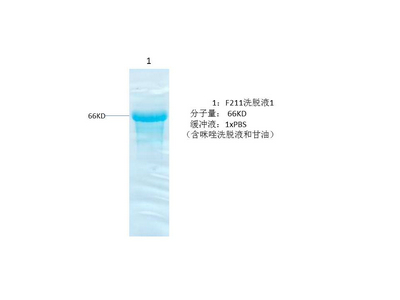- Home
- About
- Promotions
-
Products
-
Elisa Kits
- |
-
Primary antibodies
- |
-
Secondary antibodies
- |
-
Proteins
- |
-
IHC reagents
- |
-
WB reagents
- PonceauS Staining Solution
- PBST Washing Buffer, 10X
- 1.5M Tris-HCl Buffer, pH8.8
- 1M Tris-HCl Buffer, pH6.8
- 10% SDS Solution
- Prestained Protein Marker
- TBST Washing Buffer, 10X
- SDS PAGE Loading Buffer, 5X
- Stripping Buffered Solution
- Tris Buffer, pH7.4, 10X
- Total Protein Extraction Kit
- Running Buffer, 10X
- Transfer Buffer, 10X
- 30% Acr-Bis(29:1) Solution
- Tris电泳液速溶颗粒
- PBS(1X, premixed powder)
- TBS(1X, premixed powder)
- 快速封闭液
- 转膜液速溶颗粒
- Chemical reagents
- News
- Distributor
- Resources
- Contact
- Home
- >
- Info
- >
- p21 protein
- >
- Go Back
p21 protein
- Catalog No.:YD0076
- Applications:WB;SDS-PAGE
- Reactivity:Human
- Protein Name:
- p21 protein
- Sequence:
- Amino acid: 79-164, with his-MBP tag.
- Formulation:
- Liquid in PBS
- Concentration:
- SDS-PAGE >90%
- Storage Stability:
- -20°C/6 month,-80°C for long storage
- Other Name:
- Cyclin-dependent kinase inhibitor 1 ;CDK-interacting protein 1;Melanoma differentiation-associated protein 6;MDA-6;p21;
- Background:
- function:May be the important intermediate by which p53 mediates its role as an inhibitor of cellular proliferation in response to DNA damage. Binds to and inhibits cyclin-dependent kinase activity, preventing phosphorylation of critical cyclin-dependent kinase substrates and blocking cell cycle progression.,induction:By p53, mezerein (antileukemic compound) and interferon beta.,PTM:Phosphorylation of Thr-145 by Akt or of Ser-146 by PKC impairs binding to PCNA.,similarity:Belongs to the CDI family.,tissue specificity:Expressed in all adult human tissues, with 5-fold lower levels observed in the brain.,
- Function:
- regulation of cyclin-dependent protein kinase activity, G1/S transition of mitotic cell cycle, G2/M transition of mitotic cell cycle, mitotic cell cycle, regulation of cell growth, positive regulation of immune system process, regulation of leukocyte activation, positive regulation of leukocyte activation, negative regulation of protein kinase activity, induction of apoptosis, response to DNA damage stimulus, cell cycle, cell cycle arrest, positive regulation of cell proliferation,negative regulation of cell proliferation, regulation of cell size, induction of apoptosis by intracellular signals, response to radiation, response to UV, response to light stimulus, response to abiotic stimulus, response to toxin, response to endogenous stimulus, response to hormone stimulus, response to extracellular stimulus, response to organic substance, response to inorganic substance, response to organi
- Subcellular Location:
- Cytoplasm . Nucleus .
- Expression:
- Expressed in all adult tissues, with 5-fold lower levels observed in the brain.




